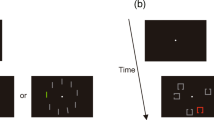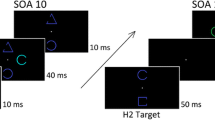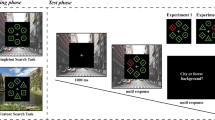Abstract
The localized attentional interference (LAI) effect was investigated in a visual search task requiring participants to simultaneously monitor two spatially separated features from the same or different dimensions. In Experiment 1, the search type was blocked and targets were defined by fixed feature values in two dimensions (e.g., a yellow item and a circular item). In contrast, in Experiment 2, participants had to look for a color and a form singleton, with the exact feature values varying randomly across trials. In both experiments, reaction times (RTs) were generally slower when two features were CLOSE to, rather than DISTANT from, each other. Moreover, RTs to CLOSE stimuli increased as the search set size increased, while RTs to DISTANT stimuli were unaffected by set size. Experiment 3 also used a singleton search task, but with the two singletons defined either in different dimensions or in the same dimension. A larger interference effect for CLOSE, as compared to DISTANT, stimuli was found for cross-dimension than for intra-dimension targets. These findings suggest that neighboring items, irrespective of whether these items are from the same or different dimensions, interfere with each other in attentional selection, and that searching for two cross-dimension targets may engage a process of dimension switching to effectively solve the ambiguity of each item, especially when these items are close to each other.



Similar content being viewed by others
References
Bahcall DO, Kowler E (1999) Attentional interference at small spatial separations. Vision Res 39:71–86
Bles M, Schwarzbach J, Weerd PD, Goebel R, Jansma BM (2006) Receptive field size-dependent attention effects in simultaneously presented stimulus displays. Neuroimage 30:506–511
Braun J, Julesz B (1998) Withdrawing attention at little or no cost: detection and discrimination tasks. Percept Psychophys 60:1–23
Braun J, Sagi D (1990) Vision outside the focus of attention. Percept Psychophys 48:45–48
Braun J, Sagi D (1991) Texture-based tasks are little affected by a second task which requires peripheral or central attentive fixation. Perception 20:483–500
Caputo G, Guerra S (1998) Attentional selection by distractor suppression. Vision Res 38:669–689
Cave KR, Zimmerman JM (1997) Flexibility in spatial attention before and after practise. Psychol Sci 8:399–403
Chelazzi L, Miler EK, Duncan J, Desimone R (1993) A neural basis for visual search in inferior temporal cortex. Nature 363:345–347
Chun MM, Wolfe JM (1996) Just say no: how are visual searched terminated when there is no target present? Cognit Psychol 30:39–78
Cutzu F, Tsotsos JK (2003) The selective tuning model of attention: psychophysical evidence for a suppressive annulus around an attended item. Vision Res 43:205–219
Found A, Müller HJ (1996) Searching for features across dimensions: evidence for a dimensional weighting account. Percept Psychophys 58:88–101
Findlay JM, Brogan D, Wenbanshith MG (1993) The spatial signal for saccadic eye-movements emphasizes visual boundaries. Percept Psychophys 53:633–641
Heinze HJ, Luck SJ, Muente TF, Gös A, Mangun GR, Hillyard SA (1994) Attention to adjacent and separate positions in space: an electrophysiological analysis. Percept Psychophys 56:42–52
Hopfinger JM, Boehler CN, Luck SJ, Tsotsos JK, Heinze HJ, Schoenfeld MA (2006) Direct neurophysiological evidence for spatial suppression surrounding the focus of attention in vision. Proc Natl Acad Sci USA 103:1053–1058
Kastner S, De Weerd P, Desimone R, Ungerleider L (1998) Mechanisms of directed attention in the human extrastriate cortex as revealed by functional MRI. Science 282:108–111
Kastner S, De Weerd P, Pinsk MA, Elizondo MI, Desimone R, Ungerleider L (2001) Modulation of sensory suppression: implications for receptive field sizes in the human visual cortex. J Neurophysiol 86:1398–1411
Kastner S, Pinsk MA, De Weerd P, Desimone R, Ungerleider L (1999) Increased activity in human visual cortex during directed attention in the absence of visual stimulation. Neuron 22:751–761
Krummenacher J, Müller HJ, Heller D (2001) Visual search for dimensionally redundant pop-out targets: evidence for parallel-coactive processing of dimensions. Percept Psychophys 63:907–917
Krummenacher J, Müller HJ, Heller D (2002) Visual search for dimensionally redundant pop-out targets: parallel-coactive processing of dimensions is location-specific. J Exp Psychol Hum Percept Perform 28:1303–1322
Lavie N (2005) Distracted and confused?: selective attention under load. Trends Cogn Sci 9:75–82
Levi DM, Hariharan S, Klein SA (2002a) Suppressive and facilitatory spatial interactions in peripheral vision: peripheral crowding is neither size invariant nor simple contrast masking. J Vision 2:167–177
Levi DM, Klein SA, Hariharan S (2002b) Suppressive and facilitatory spatial interactions in foveal vision: foveal crowding is simple contrast masking. J Vision 2:140–166
Luck SJ, Girelli M, McDermott MT, Ford MA (1997) Bridging the gap between monkey neurophysiology and human perception: an ambiguity resolution theory of visual selective attention. Cognit Psychol 33:64–78
McCarley JS, Mounts JW, Kramer AF (2004) Age-related differences in localized attentional interference. Psychol Aging 19:203–210
Moran J, Desimone R (1985) Selective attention gates visual processing in the extrastriate cortex. Science 229:782–784
Mounts JW (2000a) Evidence for suppressive mechanisms in attentional selection: feature singletons produce inhibitory surrounds. Percept Psychophys 62:969–983
Mounts JW (2000b) Attentional capture by abrupt onsets and feature singletons produce inhibitory surrounds. Percept Psychophys 62:1485–1493
Mounts JW, Gavett BE (2004) The role of salience in localized attentional interference. Vision Res 44:1575–1588
Mounts JW, Tomaselli RG (2005) Competition for representation is mediated by relative attentional salience. Acta Psychol 18:261–275
Müller HJ, Heller D, Ziegler J (1995) Visual search for singleton feature targets within and across feature dimensions. Percept Psychophys 57:1–17
Müller HJ, Krummenacher J, Heller D (2004) Dimension-specific inter-trial facilitation in visual search for pop-out targets: evidence for a top-down modulable visual short-term memory effect. Vis Cogn 11:577–602
Reynolds JH, Chelazzi L, Desimone R (1999) Competitive mechanisms subserve attention in Macaque areas V2 and V4. J Neurosci 19:1736–1753
Sagi D, Julesz B (1984) Detection versus discrimination of visual orientation. Perception 13:619–628
Slotnick SD, Hopfinger JB, Klein SA, Sutter E (2002) Darkness beyond the light: attentional inhibition surrounding the classic spotlight. Neuroreport 13:773–778
Slotnick SD, Schwarzbach J, Yantis S (2003) Attentional inhibition of visual processing in human striate and extrastriate cortex. Neuroimage 19:1602–1611
Theeuwes J (1991) Cross-dimensional perceptual selectivity. Percept Psychophys 50:184–193
Theeuwes J (1992) Percptual selectivity for color and form. Percept Psychophys 51:599–606
Treisman AM, Gelade G (1980) A feature-integration theory of attention. Cognit Psychol 12:97–136
Treisman AM, Sato S (1990) Conjunction search revisited. J Exp Psychol Hum Percept Perform 16:459–478
Wei P, Zhou X (2006) Processing multidimensional objects under different perceptual loads: the priority of bottom-up perceptual saliency. Brain Res 1114:113–124
Wolfe JM (1994) Guided search 20: a revised model of visual search. Psychon Bull Rev 1:202–238
Zhou X, Chu H, Li X, Zhan Y (2006) Center of mass attracts attention. Neuroreport 17:85–88
Acknowledgments
This study was supported by grants from the Natural Science Foundation of China (30470569, 60435010, and 30770712) to Xiaolin Zhou and by Germany DFG Research Group (FOR 480) and CoTeSys Excellence Cluster (142) grants to Hermann Müller. We thank two anonymous reviewers for their constructive comments on the earlier versions of the paper. Electronic mail concerning this study should be addressed to Dr. Xiaolin Zhou, xz104@pku.edu.cn.
Author information
Authors and Affiliations
Corresponding author
Rights and permissions
About this article
Cite this article
Wei, P., Lü, J., Müller, H.J. et al. Searching for two feature singletons in the visual scene: the localized attentional interference effect. Exp Brain Res 185, 175–188 (2008). https://doi.org/10.1007/s00221-007-1141-7
Received:
Accepted:
Published:
Issue Date:
DOI: https://doi.org/10.1007/s00221-007-1141-7




